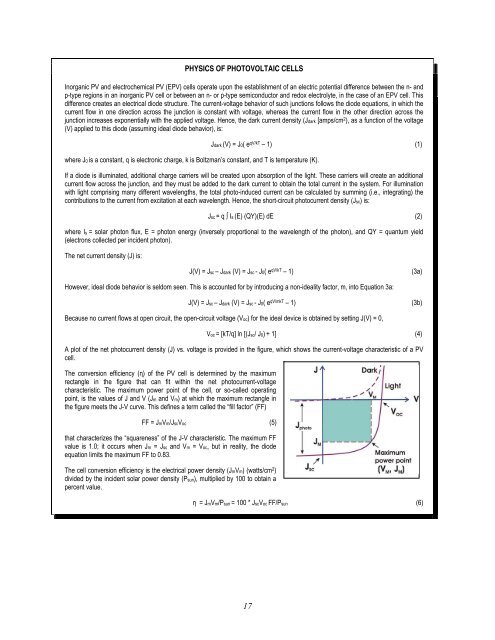Basic Research Needs for Solar Energy Utilization - Office of ...
Basic Research Needs for Solar Energy Utilization - Office of ...
Basic Research Needs for Solar Energy Utilization - Office of ...
You also want an ePaper? Increase the reach of your titles
YUMPU automatically turns print PDFs into web optimized ePapers that Google loves.
PHYSICS OF PHOTOVOLTAIC CELLS<br />
Inorganic PV and electrochemical PV (EPV) cells operate upon the establishment <strong>of</strong> an electric potential difference between the n- and<br />
p-type regions in an inorganic PV cell or between an n- or p-type semiconductor and redox electrolyte, in the case <strong>of</strong> an EPV cell. This<br />
difference creates an electrical diode structure. The current-voltage behavior <strong>of</strong> such junctions follows the diode equations, in which the<br />
current flow in one direction across the junction is constant with voltage, whereas the current flow in the other direction across the<br />
junction increases exponentially with the applied voltage. Hence, the dark current density (Jdark [amps/cm 2 ), as a function <strong>of</strong> the voltage<br />
(V) applied to this diode (assuming ideal diode behavior), is:<br />
Jdark (V) = J0( e qV/kT – 1) (1)<br />
where J0 is a constant, q is electronic charge, k is Boltzman’s constant, and T is temperature (K).<br />
If a diode is illuminated, additional charge carriers will be created upon absorption <strong>of</strong> the light. These carriers will create an additional<br />
current flow across the junction, and they must be added to the dark current to obtain the total current in the system. For illumination<br />
with light comprising many different wavelengths, the total photo-induced current can be calculated by summing (i.e., integrating) the<br />
contributions to the current from excitation at each wavelength. Hence, the short-circuit photocurrent density (Jsc) is:<br />
Jsc = q ∫ Is (E) (QY)(E) dE (2)<br />
where Is = solar photon flux, E = photon energy (inversely proportional to the wavelength <strong>of</strong> the photon), and QY = quantum yield<br />
(electrons collected per incident photon).<br />
The net current density (J) is:<br />
J(V) = Jsc – Jdark (V) = Jsc - J0( e qV/kT – 1) (3a)<br />
However, ideal diode behavior is seldom seen. This is accounted <strong>for</strong> by introducing a non-ideality factor, m, into Equation 3a:<br />
J(V) = Jsc – Jdark (V) = Jsc - J0( e qV/mkT – 1) (3b)<br />
Because no current flows at open circuit, the open-circuit voltage (Voc) <strong>for</strong> the ideal device is obtained by setting J(V) = 0,<br />
Voc = [kT/q] ln [(Jsc/ J0) + 1] (4)<br />
A plot <strong>of</strong> the net photocurrent density (J) vs. voltage is provided in the figure, which shows the current-voltage characteristic <strong>of</strong> a PV<br />
cell.<br />
The conversion efficiency (η) <strong>of</strong> the PV cell is determined by the maximum<br />
rectangle in the figure that can fit within the net photocurrent-voltage<br />
characteristic. The maximum power point <strong>of</strong> the cell, or so-called operating<br />
point, is the values <strong>of</strong> J and V (Jm and Vm) at which the maximum rectangle in<br />
the figure meets the J-V curve. This defines a term called the “fill factor” (FF)<br />
FF = JmVm/JscVoc (5)<br />
that characterizes the “squareness” <strong>of</strong> the J-V characteristic. The maximum FF<br />
value is 1.0; it occurs when Jm = Jsc and Vm = Voc, but in reality, the diode<br />
equation limits the maximum FF to 0.83.<br />
The cell conversion efficiency is the electrical power density (JmVm) (watts/cm 2 )<br />
divided by the incident solar power density (Psun), multiplied by 100 to obtain a<br />
percent value.<br />
η = JmVm/Psun = 100 * JscVoc FF/Psun (6)<br />
17
















